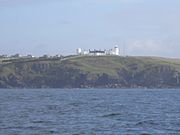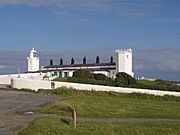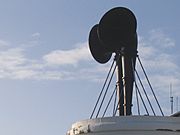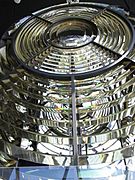Lizard Lighthouse facts for kids
| Location | Lizard Point, Cornwall, England |
|---|---|
| Coordinates | 49°57′37″N 5°12′8″W / 49.96028°N 5.20222°W |
| Year first constructed | 1619 (first) |
| Year first lit | 1751 (current) |
| Automated | 1998 |
| Deactivated | 1903 (West tower) |
| Construction | stone tower |
| Tower shape | twin octagonal towers with balcony and lantern connected by keeper's quarter |
| Markings / pattern | white tower and lantern |
| Height | 19 m (62 ft) |
| Focal height | 70 m (230 ft) |
| Original lens | 2nd order Catadioptric four-panel rotating lens |
| Intensity | 800,000 candela |
| Range | 26 nmi (48 km) |
| Characteristic | Fl W 3s. |
The Lizard Lighthouse (Cornish: Golowji Lysardh) is a famous lighthouse located at Lizard Point, Cornwall, England. It was built to help ships find their way safely through the busy English Channel. For many people returning to England, this lighthouse was a welcoming sight. On a clear night, its bright light could be seen from far away, helping sailors navigate.
Contents
History of the Lighthouse
Early Beginnings
The very first light at this spot was lit in 1619. It was built thanks to the efforts of Sir John Killigrew. However, this early lighthouse didn't last long. It was put out and the tower was taken down in 1630. This happened because it was hard to find enough money to keep it running and maintained.
The Current Lighthouse is Built
The lighthouse you see today was built in 1751. It was put up by the landowner, Thomas Fonnereau. This new lighthouse had two towers with small houses for the keepers in between them. Each tower had a large metal basket on top, called a brazier, which burned coal to create light.
In 1771, Trinity House took over the responsibility for the lighthouse. Trinity House is the official authority for lighthouses in England.
New Lamps and Fog Signals
In 1812, the coal fires were replaced with newer technology. Each tower received Argand lamps and special reflectors. These lamps were much brighter and more efficient. Each tower had 19 lamps and reflectors that stayed in a fixed position.
By 1873, even with these improvements, many shipwrecks were still happening around Lizard Point. So, a big decision was made to upgrade the lights again. They also decided to add a fog signal to help ships during foggy weather.
Electric Power Arrives
Big changes came in 1874. An engine room was built to create electric power for the lights and a loud fog siren. This engine room used special engines called caloric engines. These engines were chosen because there wasn't much fresh water nearby for steam power.
These engines powered machines called dynamo-electric machines, which then created electricity for bright arc lamps in each tower. At the same time, new lenses were installed. These were called catadioptric optics. The siren started working in January 1878, making a loud blast every five minutes. The new electric lights were first switched on in March of that same year.
In 1885, the older dynamos were replaced with more powerful generators.
Further Upgrades and Automation
More changes happened in 1903. The light and lantern on the western tower were removed. A very large, powerful rotating lens was installed in the eastern tower. This new light was so strong it could be seen from 40 to 50 miles away!
In 1908, new sirens were added. An underwater bell was also set up two miles south of the Lizard. This bell was controlled from the lighthouse using an electric cable.
The bright arc lamp was used until 1926. Then, it was replaced by an electric filament lamp. This new lamp was so good that fewer people were needed to run the lighthouse. The new system could even switch to a backup lamp automatically if the main one failed.
The engines and generators continued to be used daily until 1950. That's when the lighthouse was connected to the main electricity supply. In 1954, lighthouse keepers had to put out a fire that started in the engine room. The old clockwork system that rotated the lens was replaced with an electric motor in 1972.
Modern Day Lighthouse
In 1998, the Lizard Lighthouse became fully automated. This meant that lighthouse keepers were no longer needed to live and work there. The loud fog horn was also turned off in 1998. It was replaced with a modern electronic fog signal. As of 2022, the rotating light is still in use, guiding ships safely past Lizard Point.
Lighthouse Heritage Centre
The Lizard Lighthouse Heritage Centre opened in 2009. It received money from the Heritage Lottery Fund to help set it up. The centre is located in the old engine room of the lighthouse. You can still see some of the original engines there!
The centre has interactive displays that teach visitors about the lighthouse's history. You can learn what life was like for a lighthouse keeper and how lighthouses help keep the seas safe. As of 2023, the heritage centre was closed. The buildings around the lighthouse site are now used as holiday cottages.
Original Machinery on Display
One of the lighthouse's old electric generators is now part of the collection at Thinktank, Birmingham Science Museum. The other generator is still in its original place in the engine house. It has a special plate that says:
L'ÉLECTRICITÉ
MÉDAILLE D'OR
Exposition d'Électricité Paris 1881
No. 3 L
A de MÉRITENS, 44 rue Boursault
PARIS
Bté. s.g.d.g. en France & à l'Étranger
The carbon arc lamp, which was the main light source from 1903 to 1926, is also kept inside the lighthouse.
After the compressed-air foghorn was stopped, its machinery was left in place. Sometimes, it was even sounded for special events. Before the Heritage Centre opened, two of the four large engines were moved. They are now at the Internal Fire Museum of Power in Wales. The other two engines are still in the engine room at the lighthouse.
Gallery
See also
 In Spanish: Faro Lizard para niños
In Spanish: Faro Lizard para niños
- List of lighthouses in England






